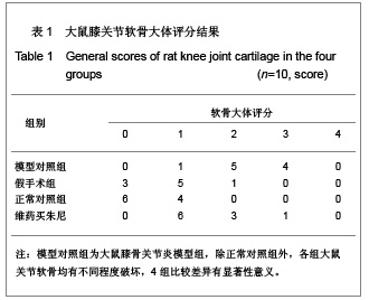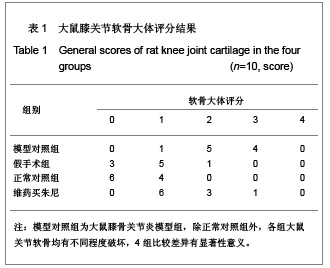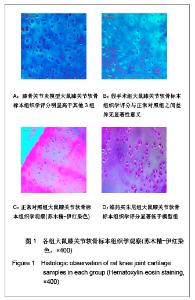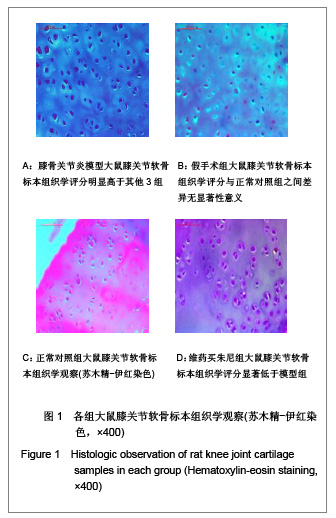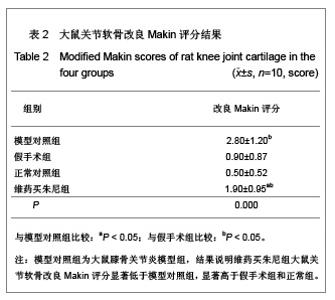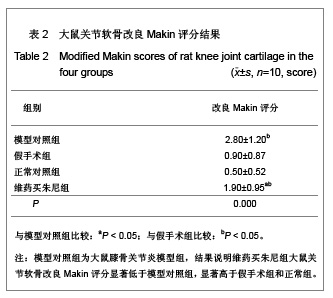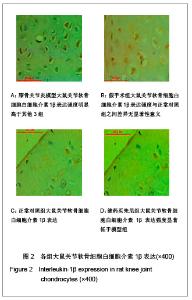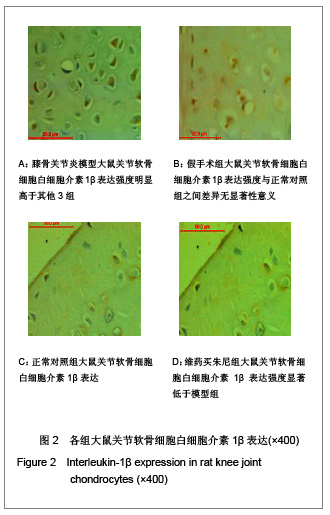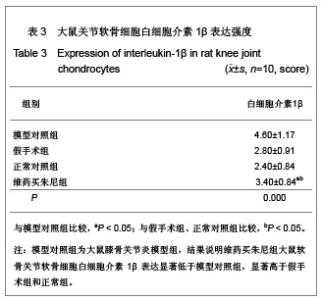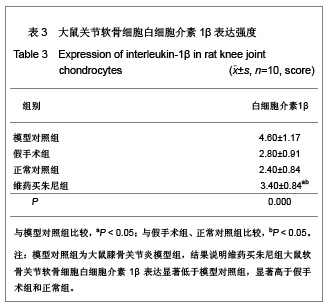| [1] Steven B, Abramson MA.Developments in the scientiWc understanding of osteoarthritis. Arthr Res Ther. 2009;11(3): 227.[2] de lsla NG, Stoltz JF.In vitroinhibition of IL-1 beta catabolic effects on cartilage: mechanism involved ondiacerein anti-OA properties. Biorheology.2008;45 (3-4):433-438.[3] Jarvinen K, Vuolteenaho K, Nieminen R, et al. Selec-tive iNOS inhibitor 1 400 W enhances anti-catabolic IL-10 and reduces destructive MMP-10 in OA cartilage. Survey of the effects of 1 400 W on inflammatory medi-ators produced by OA cartilage as detected by protein antibody array. Clin Exp Rheumato.2008;26(2):275-282.[4] Chikanza I,Fernandes L.Novel strategies for the trement of osteoarthritis.Expert Opin Investig Drugs.2000;9(7):1499.[5] Sandra K,Leo ABJ,Alison MB,et al.Different roles of tumour necrosis factorαand interleukin-1βin murine strep-tococcal cell wall arthritis.Cytokine.1998;10:690-702.[6] Hussein MR,Fathi NA,El-Din AM,et al.Alterations of the CD4(+),factor-alpha and soluble intercellular adhesion’molecule-1in rheumatoid arthritis and osteoarthritis:preliminary observations.Pathol Oncol Res. 2008;14(3):321-328.[7] Meng QC, Fang R, Wang YJ,et al. Zhongguo Zuzhi Gongcheng Yanjiu yu Linchuang Kangfu.2006,10 (35):33. 孟庆才, 方锐, 王拥军,等. 维药买朱尼对膝骨性关节炎大鼠关节软骨中Fas 及FasL mRNA表达的调节效应[J].中国组织工程研究与临床康复,2006,10 (35):33.[8] Rogart JN, Barrach HJ, Chichester CO. Articular collagen degradation in the Hulth-Telhag model of osteoarthritis. Osteoarthritis Cartilage. 1999;7(6):539-547.[9] Hu AW, Zhang L,Lv JF,et al.Zhongguo Zhongyi Gushing Ke Zazhi. 2007;15(2):42-44. 胡阿威, 张磊, 吕建芳, 等. 复方健骨关节汤治疗骨关节炎的实验研究[J]. 中国中医骨伤科杂志, 2007,15(2):42-44.[10] Felson DT, Zhang Y. An update on the epidemiology of knee and hip osteoarthritis with a view to prevention. Arthritis Rheum. 1998;41(8):1343-1355.[11] Pelletier JP, Jovanovic D, Fernandes JC, et al. Reduced progression of experimental osteoarthritis in vivo by selective inhibition of inducible nitric oxide synthase. Arthritis Rheum. 1998;41(7):1275-1286.[12] Mankin HJ,Doffman H.LippieHo L,et a1.Biochemical and metabolic abnormalities in articular cartilage from osteoarthritic human hips.II.Correlation of morphology with biochemical and metabolic data.JBone Joint Surg.1971; 53: 523-537.[13] Ota H, Igarashi S, Sasaki M, et al. Distribution of cyclooxygenase-2 in eutopic and ectopic endometrium in endometriosis and adenomyosis. Hum Reprod.2001; 16(3): 561-566.[14] Pelletier JP, Lascau-Coman V, Jovanovic D, et al. Selective inhibition of inducible nitric oxide synthase in experimental osteoarthritis is associated with reduction in tissue levels of catabolic factors. J Rheumatol.1999;26(9): 2002-2014.[15] Chin LE,Krzesicki R,Hatfield CA,et a1.Regulation of expression of IL-l receptor antagonist protein in human synovial and dermal fibrob-lasts.J Immunology.1993;150: 4008-4018.[16] Dingle JT,Honer A,Shield M.The sensitivity of synthesis of human cartilage matrix to inhibition byIL-l suggests a mechanism for the development of osteoarthritis.Cell Biochem Funt.1991;9(2):99-102.[17] Lindsley HB,Smith DD,Cohick CB,et a1.Proinflammatory cytokines enhance human synoviocyte expression of functional intercellular adhesionin molecule-1(ICAM-1).Clin lmmunol Immunopathol.1993;68(3):311-320.[18] Mrks PH,Donaldson ML.Inflammatory cytokine profiles associated with chondral damage in the anterior cruciate ligament deficient knee.Arthroscopy.2005;1:1342-1371.[19] Daheshia Yao.The interleukin 1βpathway in the pathogenesis of osteoarthritis.J Rheum.2008;35:2306-2312.[20] Yagi R, MeBurney D, Laverty D, et al. Intrajoint comparisons of gene expression patterns in human osteoarthritis suggest a change in chondrocyte phenotype. J Orthop Res.2005;23: 1128-1138.[21] Xie HJ,Du LY.Chongqing Yixue. 2011;40(4): 395. 谢辉晋, 杜远立. 骨关节炎相关细胞因子作用机制研究进展[J]. 重庆医学, 2011,40(4): 395.[22] Fan Z,Bau B,Yang H,et a1.Freshly isolated osteoarthritic chondrocytes are catabolically more active than normal chondrocytes.but less responsiveto catabolic stimulation with interleukin-1β.ArthritisRheum.2005;52:136-143.[23] Wu HK,Li RH.Zhongguo Laonianxue Zazhi. 2008;8: 1550-1553. 巫桁锞,李荣亨.白介素-l在骨关节炎发病机制中的作用[J].中国老年学杂志,2008,28(8):1550-1553.[24] Xu DH,Yaoxue Fuwu yu Yanjiu. 2005,5(1):231. 徐东红.白介素与骨关节炎[J].药学服务与研究,2005,5(1):231.[25] Su YX, Chen SY, Lin QJ, et al.Fujian Zhongyi Xueyuan Xuebao. 2006;16(2):38. 苏友新,陈顺有,林清坚,等.壮骨健膝方对膝骨性关节炎患者关节滑液细胞因子、NO的影响[J].福建中医学院学报,2006,16(2):38.[26] Yan J,Jie XG,Meng J,et al..Zhongguo Zhongyi Gushang Zazhi. 2009,17(7):5-6. 燕军,节晓光,孟江. 苗药荣筋汤治疗兔KOA IL-1β 、TNF-α水平观测[J]. 中国中医骨伤科杂志,2009,17(7):5-6. |
